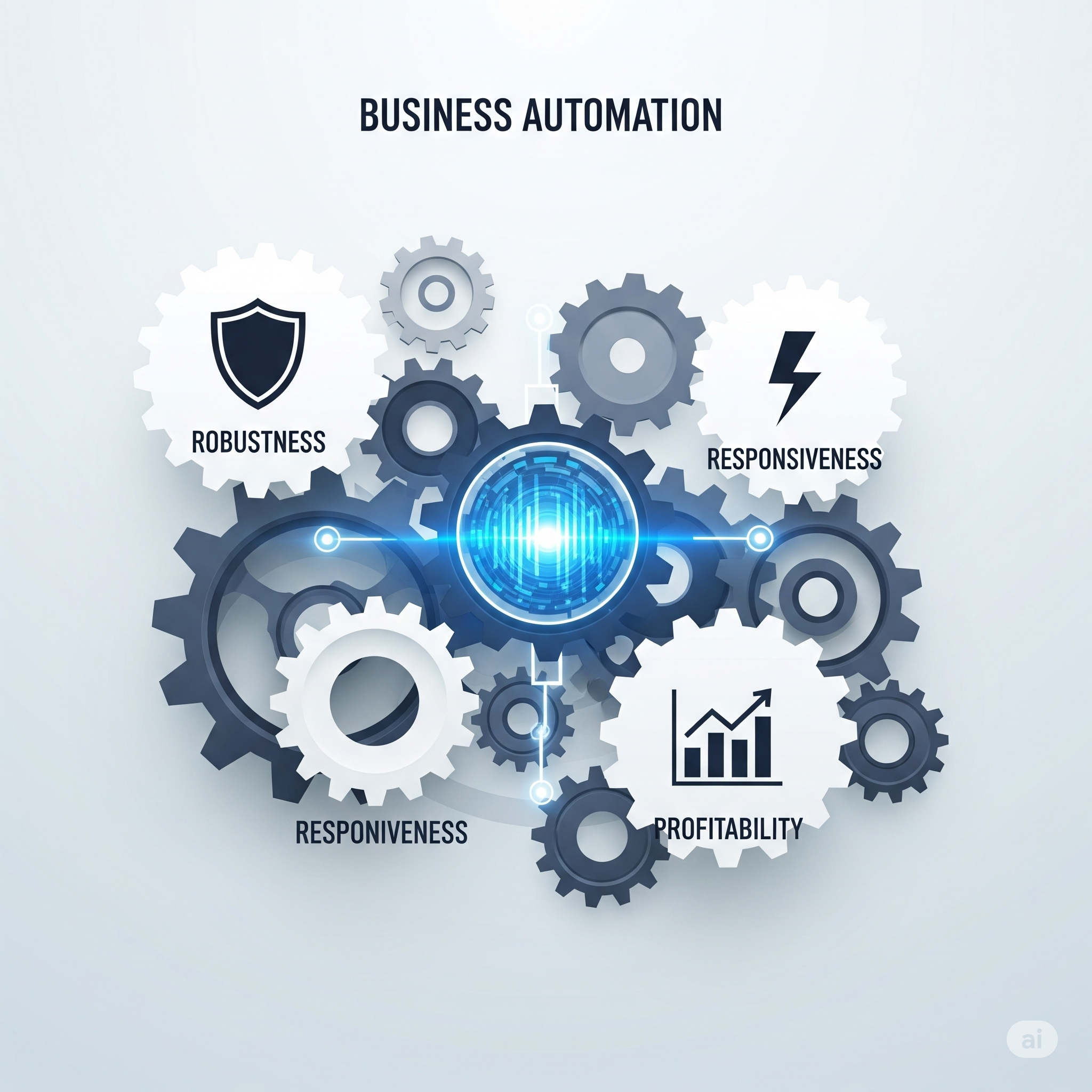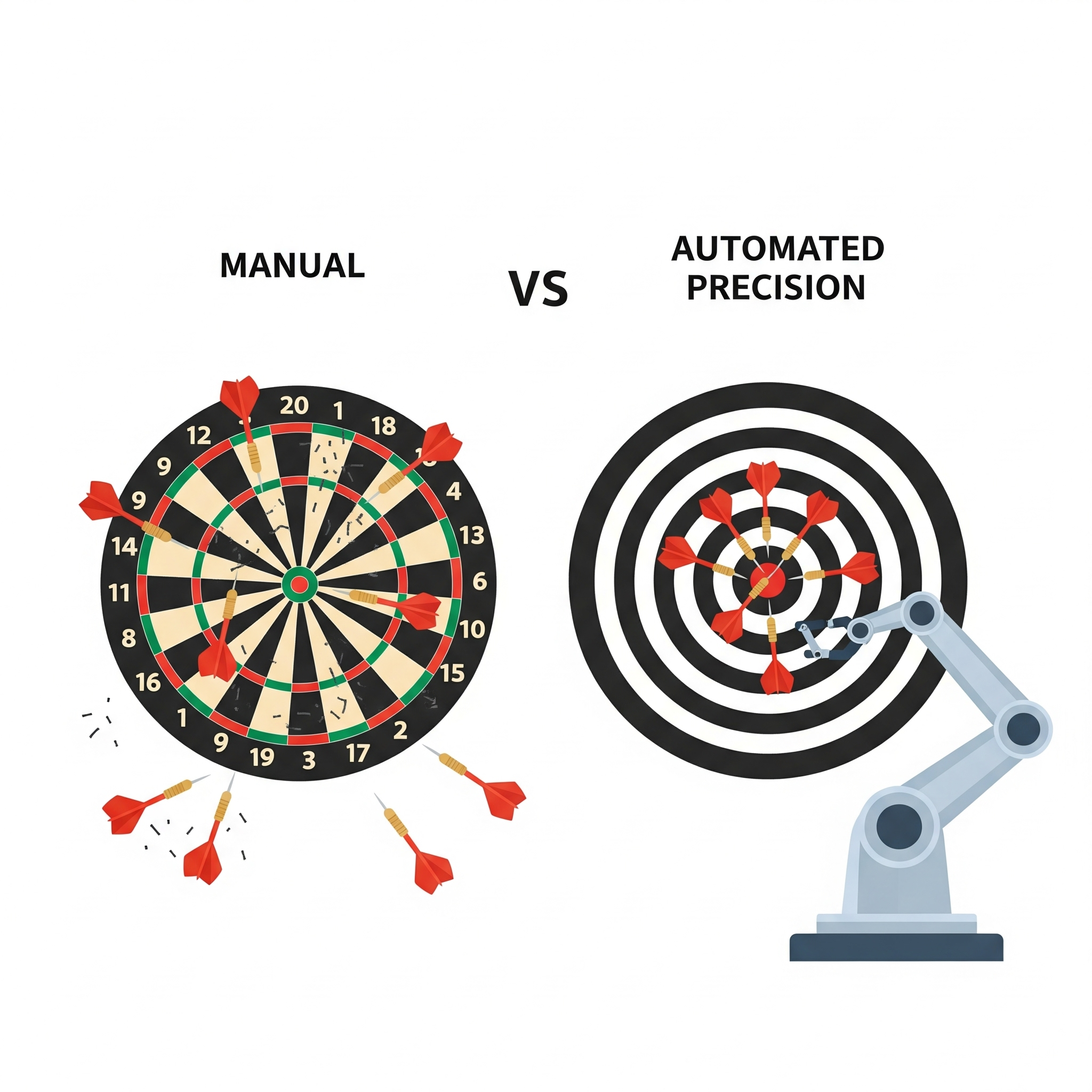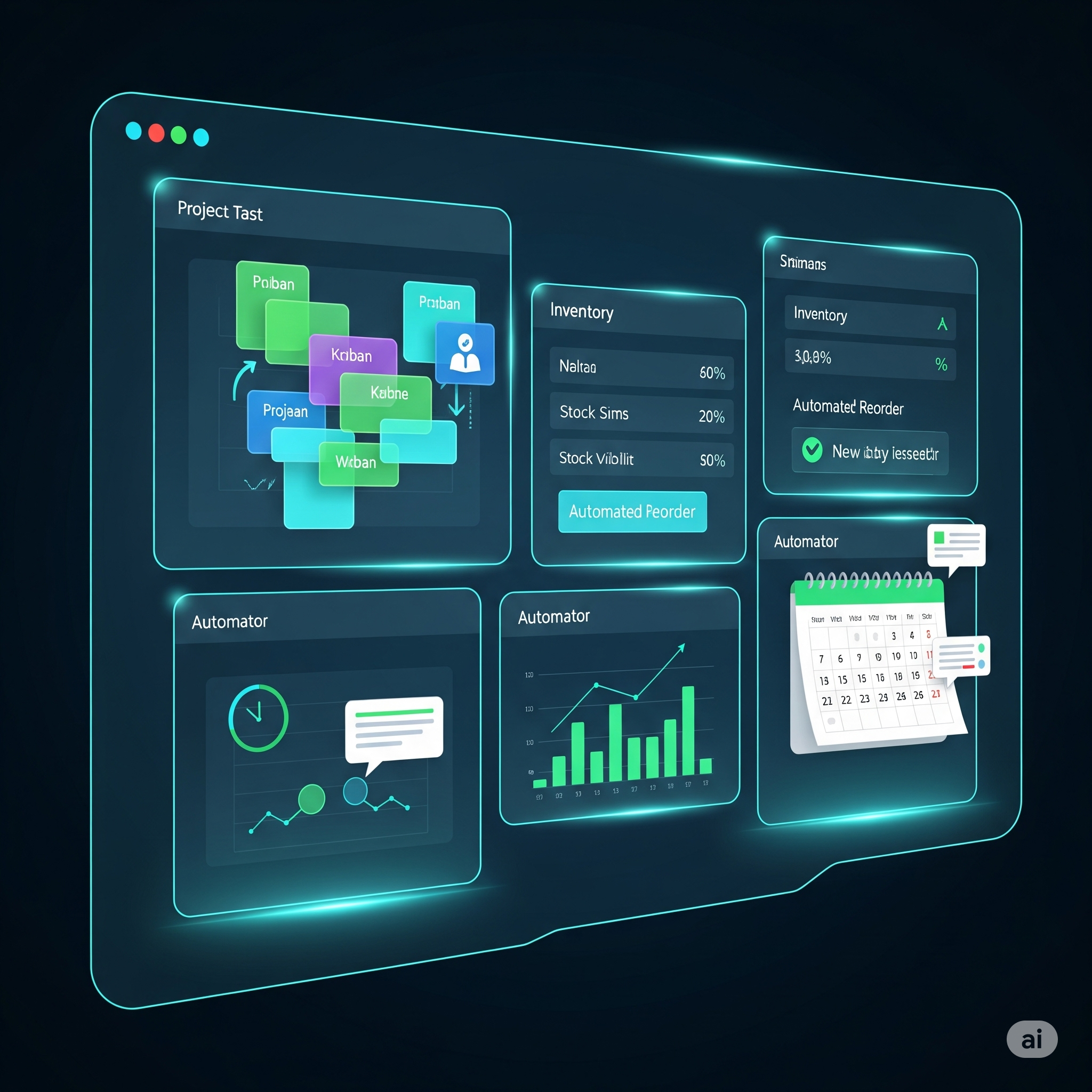Imagine waking up tomorrow with a few extra hours in your day. Not just an hour, not two, but a significant chunk of time that magically appeared, unburdened by the endless stream of repetitive tasks that usually consume your every waking moment. What would you do with that time? Would you finally strategize that big growth initiative you’ve been dreaming of? Would you spend it innovating, creating new products or services that truly set your small business apart? Or perhaps, just perhaps, would you finally take a deep breath, spend quality time with your family, or even, dare I say, enjoy a hobby?
For countless small business owners, this scenario sounds like a fantasy. The reality is often a relentless juggle: answering emails, scheduling appointments, chasing invoices, posting on social media, managing inventory, dealing with customer queries, and a hundred other hats you wear, often simultaneously. You started your business to pursue a passion, to achieve financial independence, to make an impact, but somewhere along the way, you became an administrative powerhouse, bogged down in the minutiae.

But what if I told you that this dream of reclaimed time and boosted efficiency isn’t just a fantasy? What if there was a powerful, accessible force that could lift the burden of these mundane, yet essential, tasks from your shoulders, allowing you to focus on what truly matters: growth, vision, and enjoying the life you’re building? That force, my friends, is automation.
This isn’t about replacing the human touch; it’s about augmenting it. It’s not about turning your small business into a cold, robotic entity; it’s about freeing up your invaluable human capital – your brain, your creativity, your passion – to do the work that only you can do. Automation, in its essence, is the art and science of leveraging technology to perform repetitive tasks with minimal human intervention. It’s about setting up systems that run themselves, tirelessly, accurately, and without complaint, so you don’t have to.
And here’s the best part: it’s no longer the exclusive domain of corporate giants with unlimited budgets. The landscape of automation tools has exploded, offering incredibly powerful, user-friendly, and often surprisingly affordable solutions specifically designed for the lean, agile, and ambitious small business. This isn’t a guide filled with abstract theories; this is your ultimate, actionable roadmap to transforming your small business from a time-suck into a well-oiled, efficient machine. We’re going to dive deep, explore the what, the why, and most importantly, the how, so you can stop just surviving and start truly thriving. Get ready to reclaim your time, boost your bottom line, and rediscover the joy of entrepreneurship.

So, why should a busy small business owner even consider dedicating precious time to learning about automation, let alone implementing it? The benefits extend far beyond simply ticking off tasks. They fundamentally reshape the way your business operates, making it more robust, more responsive, and ultimately, more profitable.
First and foremost, let’s talk about the most obvious and arguably most appealing benefit: time freedom. This isn’t just a catchy phrase; it’s a tangible outcome. Every single email you manually compose, every appointment you manually schedule, every social media post you manually upload, every invoice you manually chase – these are minutes, hours, days that accumulate. Imagine automating just 20% of these tasks. That’s 20% of your workweek freed up. What would you do with that newfound time? You could finally dedicate hours to strategic planning, analyzing market trends, or developing new products. You could invest in relationships with your most valuable customers, deepening their loyalty. You could even step away from the business for a moment, recharge your batteries, and come back with renewed energy and perspective. For the small business owner, time is the most precious, non-renewable resource, and automation is a master key to unlocking more of it.
Next, automation is a direct pathway to significantly increased efficiency and productivity. When tasks are automated, they are executed consistently and quickly, without the delays inherent in manual processes. Think about order processing. A customer places an order online, an automated system confirms payment, updates inventory, triggers a shipping label, and sends a tracking number, all within seconds. No human intervention needed until it’s time to pack the physical item. This isn’t just faster; it’s more accurate. Your team, or even just yourself, is freed from the grunt work, allowing them to focus on higher-value activities that require human creativity, problem-solving, and emotional intelligence. The cumulative effect is a small business that simply gets more done, with less effort, and fewer bottlenecks.

And speaking of accuracy, let’s highlight improved accuracy and a dramatic reduction in errors. Human beings, bless our wonderful, creative, sometimes distractible minds, make mistakes. Typos happen, numbers get transposed, steps are occasionally missed in a repetitive process. Computers, on the other hand, are tireless and precise. Once an automation rule is set up correctly, it will execute that rule flawlessly, every single time. This means fewer accounting discrepancies, fewer customer service complaints due to incorrect information, and fewer reworks. For a small business, where every error can have an outsized impact on reputation and profitability, this benefit alone can be a game-changer.
Cost reduction, while sometimes less direct, is another powerful advantage. Automation doesn’t always mean immediately firing staff, especially in a small business where teams are lean and multi-talented. Instead, it means getting more out of your existing resources. If your team is spending less time on repetitive data entry, they have more capacity for strategic work, reducing the need to hire additional staff as your business grows. Fewer errors mean fewer costs associated with corrections, returns, or customer dissatisfaction. Efficient processes also translate to faster revenue cycles, such as automated invoicing and payment reminders leading to quicker cash flow. Over time, the investment in automation tools often pays for itself many times over in saved wages and increased operational capacity.

Perhaps one of the most exciting benefits is an enhanced customer experience. In today’s competitive landscape, customer expectations are incredibly high. They expect fast responses, personalized interactions, and 24/7 availability. Automation makes this not just possible, but often effortless. Chatbots can answer common questions instantly, day or night. Automated email sequences can provide personalized recommendations or follow up on abandoned carts. Automated appointment reminders reduce no-shows. By streamlining these interactions, your small business can provide a consistently excellent and highly responsive experience that builds loyalty and differentiates you from the competition. Happy customers are repeat customers, and they’re your best marketing ambassadors.
Furthermore, automation is the backbone of true scalability. As your small business grows, the volume of tasks inevitably increases. Without automation, this growth often necessitates a proportional increase in headcount, which brings its own set of challenges, costs, and management overhead. With automation, you can significantly increase your operational capacity without a linear increase in staff. An automated invoicing system can handle 10 invoices or 10,000 invoices with minimal additional effort. This allows your small business to expand its reach, serve more customers, and handle larger volumes of transactions without breaking the bank or buckling under administrative pressure.
Beyond the immediate operational benefits, automation also provides better data and insights. When processes are automated, data is captured consistently and often in a structured format. This makes it easier to track key performance indicators, generate reports, and understand trends. For example, automated email marketing platforms provide detailed analytics on open rates, click-through rates, and conversions. Automated sales funnels track leads from initial contact to conversion. This invaluable data empowers you to make more informed, data-driven decisions about your marketing, sales, customer service, and overall business strategy, moving you from guesswork to calculated action.
Finally, integrating automation into your small business offers a significant competitive advantage. While many small businesses are still stuck in manual, time-consuming processes, you can leapfrog them by delivering faster, more accurate service, and by dedicating more of your strategic time to innovation. This isn’t about outspending them; it’s about outsmarting them and out-executing them through intelligent use of technology. It also contributes to higher employee satisfaction and retention. When your team is freed from repetitive, soul-numbing tasks, they can engage in more fulfilling work that leverages their skills and intelligence. This leads to happier employees, lower turnover, and a more vibrant, engaged workplace culture, which is especially important for the often tight-knit teams within a small business.
Now that we’ve firmly established the compelling “why,” let’s dive into the practical “where.” Where exactly within your small business can you begin to apply the power of automation? The beauty of automation lies in its versatility. It can touch almost every facet of your operations, transforming mundane tasks into seamless workflows. Think of your business as a collection of departments, even if you’re a solopreneur wearing all the hats. Each “department” likely has repetitive tasks ripe for automation.

Let’s start with the lifeblood of any business: Marketing and Sales. This is an area where automation can deliver truly transformative results for a small business. Consider email marketing. Instead of manually sending out newsletters or promotional offers, an email marketing platform can automate segmentation (sending specific emails to specific customer groups based on their interests or past purchases), drip campaigns (a series of pre-written emails sent over time, perfect for welcoming new subscribers or nurturing leads), and even automated welcome sequences for new customers. Imagine a customer making a purchase, and automatically receiving a thank-you email, followed by a request for review a week later, and then a personalized offer based on their purchase history a month later. All without you lifting a finger after the initial setup.
Social media management is another prime candidate. Instead of manually posting to Facebook, Instagram, and LinkedIn every day, social media scheduling tools allow you to plan and schedule content weeks or even months in advance. Many also offer analytics to track performance and even listening tools to monitor mentions of your brand. This frees you from the daily grind of posting and allows you to focus on engaging with your audience and strategizing your content.
Then there’s the core of sales: Customer Relationship Management (CRM). For a small business, a CRM system isn’t just about storing contact information; it’s about automating your sales pipeline. It can track leads from initial contact, remind you to follow up, log interactions, and even automate personalized email outreach at various stages of the sales process. Some CRMs can automatically qualify leads based on their interactions with your website or emails, telling you exactly who to focus your precious sales time on. Lead generation and nurturing can be greatly enhanced by automation too, through automated web forms that feed directly into your CRM, chatbots on your website that answer initial questions and qualify visitors, and automated lead scoring that identifies your hottest prospects. Even basic ad management can be partially automated, allowing you to set rules for budget allocation or A/B testing ad creatives, optimizing your spend.
Moving beyond marketing and sales, let’s explore Customer Service and Support. This is where automation can truly elevate your small business’s reputation and responsiveness. Chatbots and AI assistants on your website or social media channels can handle common frequently asked questions (FAQs) instantly, freeing your human staff (or yourself) from repetitive queries. They can guide customers to relevant information, qualify leads, or even initiate basic support tickets. Help desk software automates ticket management, ensuring no query falls through the cracks, routing issues to the right person, and providing automated responses acknowledging receipt and offering updates. Knowledge bases, once populated, act as self-service portals, allowing customers to find answers independently, reducing the need for direct interaction. Even collecting customer feedback can be automated, sending out surveys after a purchase or service interaction, giving you invaluable insights without manual follow-up.

Next up, Operations and Project Management. This is the engine room of your small business. Recurring tasks, the silent time-killers, are perfect for automation. Task management tools can create recurring tasks, assign them, and send reminders. Workflow automation can handle approvals, document routing, and notifications, ensuring tasks move smoothly from one stage to the next without manual oversight. Project tracking and reporting can be streamlined, giving you real-time visibility into project progress. For product-based businesses, inventory management automation is a lifesaver. Systems can automatically notify you when stock levels are low, even triggering reorder requests to suppliers. Appointment scheduling, a massive time-drain for many small businesses, can be entirely automated, allowing customers to book times directly into your calendar based on your availability, sending reminders, and even processing payments.
Financial and Administrative tasks, often dreaded, are ripe for automation. Bookkeeping and accounting software can integrate directly with your bank accounts, credit cards, and payment processors, automatically categorizing transactions. This drastically reduces manual data entry and makes reconciliation a breeze. Invoicing and payment reminders are perhaps the most common and beneficial financial automations. Software can automatically generate and send invoices, track their status, and send polite reminders for overdue payments, significantly improving cash flow. Receipt management apps can automatically scan and categorize receipts, eliminating manual entry and making tax time infinitely easier. Even bill pay can be automated for recurring expenses, ensuring you never miss a payment. Document management and e-signatures streamline administrative processes, allowing you to send, sign, and store documents digitally without printing, scanning, or mailing.
Finally, even for small teams, Human Resources Automation can make a significant difference. Think about onboarding and offboarding checklists. Instead of manually remembering every step, an automated checklist ensures consistency and compliance. Time tracking and PTO requests can be managed through simple apps, eliminating spreadsheets and manual calculations. Performance review reminders can be automated. Even initial candidate screening, such as sending out pre-qualifying questionnaires or scheduling initial calls, can be partially automated to filter out unsuitable applicants before you invest your precious time.
The sheer breadth of possibilities might feel overwhelming, but remember the key: start small, think big. The “where” is everywhere there’s a repetitive task. The trick is identifying the right “where” for *your* small business.

Now, let’s get down to the most crucial part: the “how.” How do you actually implement automation in your small business without getting bogged down, overwhelmed, or wasting resources? This isn’t a race; it’s a strategic journey. Here’s your step-by-step playbook to successful automation.
Step 1: Audit Your Current Processes. This is perhaps the most critical foundational step, and one that many eager small business owners skip in their rush to implement new tools. Before you automate anything, you need to deeply understand what you’re currently doing. Identify repetitive, time-consuming, and error-prone tasks. Grab a pen and paper, or open a document, and list every single task you or your team performs regularly. Be brutally honest. Is it answering the same five customer questions daily? Is it manually copying data from one spreadsheet to another? Is it chasing late payments? As you list them, ask yourself: Is this task repetitive? Does it take a significant amount of time? Is it prone to human error? Then, map out your current workflows. For example, how does an inquiry become a sale? What are the steps? Who does what, and when? Don’t be afraid to involve your team in this exercise; they are on the front lines and often have invaluable insights into inefficiencies and pain points. Once you have a clear picture, prioritize based on impact and feasibility. Which tasks, if automated, would free up the most time or solve the biggest problems? Which ones seem easiest to automate? Start with the “low-hanging fruit” – tasks that are simple, highly repetitive, and have a clear, measurable outcome if automated.
Step 2: Define Your Automation Goals. After identifying the tasks, clarify what you want to achieve by automating them. Vague goals lead to vague results. Make your goals SMART: Specific, Measurable, Achievable, Relevant, and Time-bound. Instead of “I want to save time,” aim for “I want to save 10 hours per week on administrative tasks within the next three months.” Instead of “I want better customer service,” aim for “I want to reduce customer response time by 50% using an automated chatbot within six weeks.” Clearly defined goals will guide your tool selection, motivate your efforts, and provide a benchmark for success.
Step 3: Research and Select the Right Tools. This is where many small business owners get stuck, overwhelmed by the sheer number of options. Remember, the goal isn’t to find the “best” tool universally, but the best tool for *your* specific needs, goals, and budget. When researching, consider a few key aspects. First, do you need a small, niche solution for a very specific task (like an appointment scheduler), or are you looking for a more all-in-one platform (like a comprehensive CRM)? Often, starting with niche solutions for high-impact areas is less overwhelming. Second, consider integration capabilities. Can the tool seamlessly connect with other software you already use, or plan to use? This is crucial for creating truly automated workflows. Tools like Zapier or Make (formerly Integromat) are general-purpose automation platforms that act as “connectors” between thousands of different apps, allowing you to build complex automations even if the apps don’t natively integrate. Third, think about scalability. Can the tool grow with your small business, or will you outgrow it quickly? Fourth, and critically for a small business, how easy is it to use? Does it require extensive technical knowledge, or is it intuitive enough for you and your team to pick up quickly? Finally, evaluate the cost. Look for free trials, freemium models (free for basic features), and tiered pricing plans. Focus on the potential return on investment (ROI) rather than just the upfront cost. A tool that costs $50 a month but saves you 10 hours of work (worth far more than $50) is a clear win. Don’t forget to check customer support and community forums – good support can be invaluable when you’re learning.
Step 4: Implement Incrementally (Crawl, Walk, Run). This is the golden rule of automation for small businesses. Do not try to automate everything at once. You’ll get overwhelmed, make mistakes, and likely give up. Instead, start with one small, high-impact area that you identified in Step 1. Maybe it’s just automating your appointment scheduling, or setting up a simple email welcome sequence. Implement that one automation, test it thoroughly, and ensure it works perfectly. Don’t be afraid to iterate and optimize it. Once that’s running smoothly and delivering results, move on to the next highest priority. This iterative approach builds confidence, allows you to learn as you go, and minimizes disruption to your existing operations. Think of it like building blocks; one successful automation provides a stable foundation for the next.
Step 5: Train Your Team and Foster Adoption. Automation isn’t just about software; it’s about people. If you have a team, their buy-in and cooperation are absolutely essential. Explain the “why” behind the automation: how it will benefit them by freeing them from mundane tasks, allowing them to focus on more creative and rewarding work. Provide clear instructions and comprehensive training on any new tools or processes. Don’t just throw a tool at them and expect them to figure it out. Offer ongoing support, answer their questions, and address any concerns or resistance. Celebrate small wins publicly to show the tangible benefits of automation. When they see that automation helps them, they’ll become advocates, not opponents.
Step 6: Monitor, Evaluate, and Optimize. Automation is not a one-time setup and then forget about it. It’s an ongoing process of refinement. Regularly monitor the performance of your automated workflows. Are they achieving your SMART goals from Step 2? Track your KPIs (Key Performance Indicators) related to the automated areas. Gather feedback from your team and your customers. Is the chatbot actually helping customers, or is it frustrating them? Is the automated invoicing system truly improving cash flow? Be prepared to adjust, tweak, and optimize your automations. Technology evolves, your business evolves, and so should your automated processes. What works perfectly today might need a slight adjustment tomorrow, or a complete overhaul in a year. Treat your automation systems as living entities that require regular care and attention.

Even with the best intentions and a clear roadmap, the journey to automation for a small business isn’t always perfectly smooth. There are common challenges and pitfalls that can trip you up, but knowing about them beforehand can help you navigate them effectively.
One of the most prevalent challenges is the fear of technology and complexity. Many small business owners grew their enterprises through sheer grit and personal touch, not necessarily through technological prowess. The idea of integrating complex software can be daunting. The solution here is to remember Step 4: Implement Incrementally. Start with tools that are known for their user-friendliness and clear interfaces. Don’t aim for the most complex, feature-rich solution right away. Look for “no-code” or “low-code” automation platforms that allow you to build workflows visually without needing programming knowledge. Confidence builds with small successes.
Cost concerns are another significant hurdle. While automation promises long-term savings, there’s often an upfront investment in software subscriptions. As discussed, always focus on the ROI. What is the value of the time saved, the errors prevented, or the increased revenue generated? Many excellent tools offer free trials or freemium models, allowing you to test their effectiveness before committing financially. Explore open-source alternatives or tools with per-user pricing that scales with your needs, not just a flat, high fee. Remember that for a small business, every dollar counts, but a dollar invested wisely in automation can yield substantial returns.
Data security and privacy are paramount, especially when you’re entrusting customer or financial data to third-party software. Before selecting any tool, thoroughly research its security protocols, data encryption practices, and privacy policies. Ensure compliance with relevant regulations (like GDPR if you serve European customers, or CCPA if you serve Californians). Choose reputable, well-established providers with a strong track record. Never compromise on security for convenience or cost.
Integration headaches can plague even the most tech-savvy. You might find two amazing tools, but they just don’t “talk” to each other. This is precisely where general-purpose integration platforms like Zapier, Make, or even native integrations built into larger platforms come into play. They act as the universal translators that allow disparate apps to exchange information and trigger actions. Plan your integrations before you commit to too many tools that don’t play well together. A single, powerful integration platform can simplify your entire automation ecosystem.
A big concern for many small businesses, and rightly so, is the fear of losing the personal touch. Your unique brand, your hands-on approach, your direct relationship with customers – these are often what differentiate a small business. Automation should never replace genuine human connection where it truly matters. Instead, it should free you to *enhance* that connection. Automate the mundane, but leave the meaningful interactions for human intervention. Use automation to identify when a customer needs a personal call, or to send a personalized follow-up after an automated interaction. The key is knowing where to draw the line. Don’t automate your empathy; automate the mechanics that allow you to deliver it more consistently.
Over-automating is a subtle but real pitfall. Don’t automate for automation’s sake. Just because a task *can* be automated doesn’t mean it *should* be. Some tasks benefit from human judgment, creativity, or direct interaction. Automating a process that isn’t fully understood or is inherently flawed will only automate inefficiency and errors. This loops back to Step 1 of the “how”: audit your processes first. Automate only what makes sense and brings a clear benefit.
Finally, a lack of clear strategy is a common stumbling block. Without a clear “why” and well-defined SMART goals, automation efforts can become fragmented, leading to a collection of disconnected tools rather than a cohesive, efficient system. Always return to your business objectives. How does this automation help you achieve your larger vision for your small business? If you can’t articulate a clear benefit, it might not be the right automation for you right now.
Looking ahead, the future of automation for small businesses is incredibly exciting and rapidly evolving. We’re already seeing the increasing integration of Artificial Intelligence (AI) and Machine Learning (ML) into everyday automation tools. This isn’t just about setting up rules; it’s about systems that can learn from data, make predictions, and even automate more complex decision-making processes.
Imagine AI-powered chatbots that not only answer FAQs but can understand customer sentiment and route urgent queries based on emotional cues. Picture machine learning algorithms that automatically segment your customer base with incredible precision, predicting their next purchase and triggering hyper-personalized marketing campaigns tailored to individual preferences. Think of predictive analytics for inventory management that not only reorders stock but forecasts demand based on historical sales, seasonality, and external factors like weather patterns or current events.

This future isn’t some distant sci-fi fantasy; elements of it are already here and becoming more accessible for small businesses. As AI becomes more embedded into user-friendly platforms, it will elevate automation beyond simple task repetition, moving towards intelligent process optimization.
The evolving role of the small business owner in this automated future is perhaps the most profound shift. You will move from being primarily a doer, bogged down in operational minutiae, to becoming an even more impactful strategist, innovator, and relationship builder. Automation frees you to think bigger, to nurture creativity, and to focus on the human elements of your business that technology cannot replicate. Your time will be dedicated to vision setting, strategic partnerships, fostering your team’s growth, and truly understanding and delighting your customers at a deeper level. You’ll be able to step back and work *on* your business, not just *in* it, a distinction that every successful entrepreneur knows is vital for sustainable growth.
So, where does this leave us? It leaves us with an undeniable truth: automation is no longer a luxury; for the modern small business, it’s a necessity. It’s the invisible hand that supports your growth, the silent partner that works tirelessly behind the scenes, and the powerful enabler of the time freedom you desperately crave. It’s the key to unlocking new levels of efficiency, accuracy, and customer satisfaction, allowing you to not just compete, but to truly excel in a dynamic marketplace.
This isn’t about becoming a robot; it’s about embracing tools that make you more human, more strategic, and more effective. It’s about letting the machines do what they do best – the repetitive, the data-heavy, the scheduled – so you can do what only you, as a passionate small business owner, can do best: innovate, connect, and lead.
Don’t let the idea of automation intimidate you. Remember the ultimate goal: more time, less stress, and a thriving business. Start today. Even if it’s just one small step. Pick one repetitive task, audit its process, and research a single tool that can automate it. Take that first leap. The journey of freeing up your time and boosting your efficiency begins with that single, decisive step. Your future, more relaxed, more strategic, and more successful self will thank you for it. Go forth and automate!



